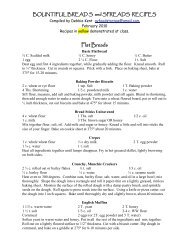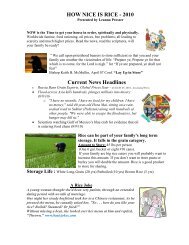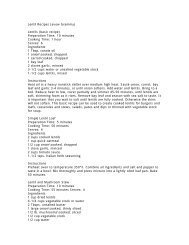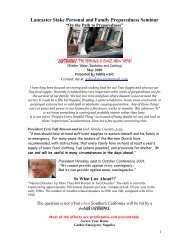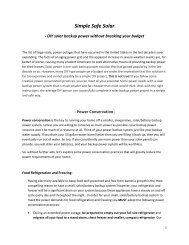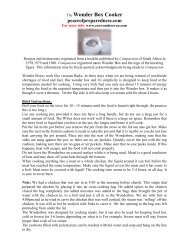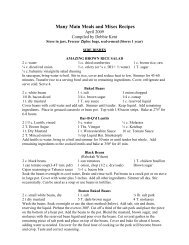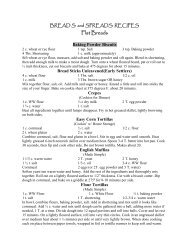Got Milk Recipes.pdf - Peace of Preparedness
Got Milk Recipes.pdf - Peace of Preparedness
Got Milk Recipes.pdf - Peace of Preparedness
Create successful ePaper yourself
Turn your PDF publications into a flip-book with our unique Google optimized e-Paper software.
CHEESE AND YOGURTThese recipes have been collected from many sources. None are original withme. Some <strong>of</strong> the recipes were found in multiple places, with no way I could determinewho was the original creator <strong>of</strong> the recipe, so all <strong>of</strong> the sources I used can be found atthe end <strong>of</strong> the handout.Most <strong>of</strong> these recipes use vinegar or lemon juice (direct acid method) to make thecheese rather than rennet (junket) because I don’t have rennet (junket) stored, but I dohave vinegar, and cider, both <strong>of</strong> which are easy to make. The same cannot be said forrennet!Whey based powdered milk drink mixes such as Morning Moo, Swiss Maid, andothers will NOT work for making cheese or yogurt! These products are made from theliquid left over after making cheese commercially.Helpful TipsFlavor-causing enzymes come from bacteria which produce acid and then releaseenzymes. That bacteria is found in commercial cheese making cultures, but since thosecultures are expensive and have a very short shelf life, I eliminate the long culturingprocess and use an acid to curdle the milk while the milk is heating, sometimes addingbuttermilk or other spices and herbs. When I want a different flavor or texture, or acheese that can be aged for one or two months, I use buttermilk, yogurt, or acidophilusas cultures.Drain and rinse cheese made with old, yellowed, strong tasting/smelling, or rancidmilk powder to improve color and flavor. The use <strong>of</strong> vinegar in the processing greatlyreduces the problem <strong>of</strong> rancidity, plus by rinsing the cheese first in hot water whichseems to take out the strong taste, then in cold water, which lightens the color and firmsthe curd, you can usually make a fine tasting homemade cheese. Some people think thehot water rinse should not be done because the resulting cheese has more <strong>of</strong> the cheeseflavor we are used to. Do what your family likes best!Cheese colorings can be added to any recipe during the blending process. Dairies, somehealth food or preparedness stores and mail order catalogs for cheese supplies carryliquid or tablet forms <strong>of</strong> yellow coloring. Paste coloring can be obtained from stores thatcarry cake decorating supplies. Ordinary food coloring made for home use is notpermanent and will not work as it rinses out during the rinsing and draining process.The best pan to use for cheese making will be made <strong>of</strong> copper because the copper aidsthe curdling process. Do NOT use an aluminum pan, or spoon.Let the cheese set in the pan until it has formed a fairly solid curd, well separated fromthe whey. This may take 45 minutes to 2 hours. Carefully pour <strong>of</strong>f the whey, then cutthe curd (with a plastic or stainless steel knife) into pieces about thumb size. Pour <strong>of</strong>fthe whey again. Rinse curds at least 3 times, gently lifting with your hand to stir them



